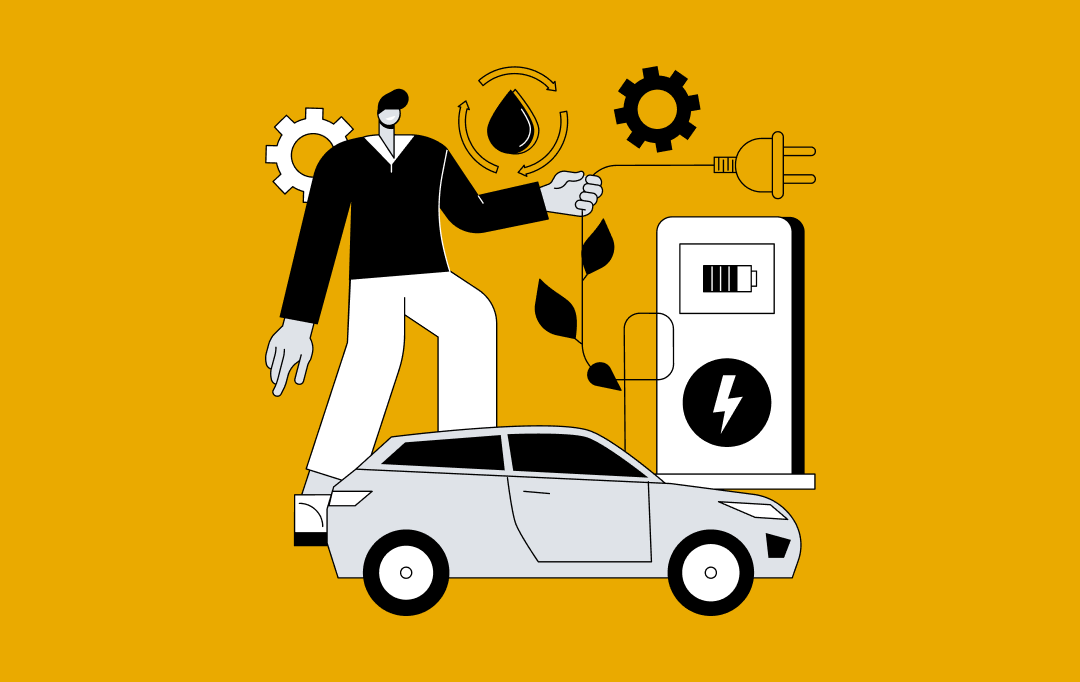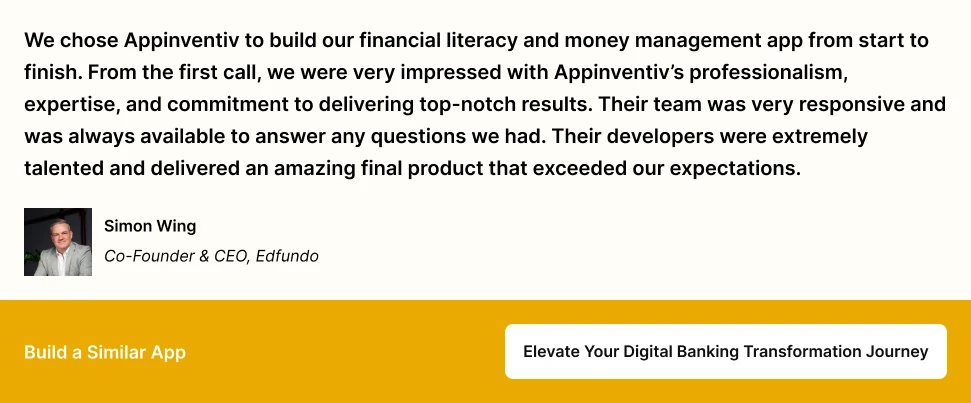- The Shift from Traditional to Digital Banking
- Key Factors Driving Digital Transformation in Banking
- Customer-Centric Approach
- Operating Model
- Modernized Infrastructure
- The Power of Data
- Digitally-Driven Market
- Customer Expectations
- Technological Advancements
- Regulatory Changes
- Cost Efficiency
- Technologies Defining the Today and Tomorrow of Digital Banking for Businesses
- Artificial intelligence (AI)
- Machine learning (ML)
- Internet of Things (IoT)
- Blockchain
- Cloud Computing and APIs
- Big Data Analytics
- Cybersecurity Technologies
- 5G Connectivity
- Augmented Reality (AR) & Virtual Reality (VR)
- Quantum Computing
- Digital Identity & e-KYC Solutions
- How to Drive Effective Digital Change in the Banking Sector
- 1. Assessment and Vision
- 2. Strategy Development
- 3. Technology Integration
- 4. Legacy System Modernization
- 5. Data Management and Personalization
- 6. Regulatory Compliance and Risk Management
- 7. Change Management and Employee Training
- 8. Continuous Innovation
- 9. Performance Measurement and Agility
- 10. Sustainability and Ethical Banking
- Challenges of Digital Transformation in Banking And Solutions to Overcome Them
- Benefits of Digital Transformation in Banking and What It Means for Businesses
- Investment Banking on Digital Platforms
- Revolutionizing Investment Banking
- Improved Customer Experience
- Better Compliance through Digital Solutions
- Easier New Customer Acquisition
- Boosting Business Innovation and Adaptability
- Stronger Security and Fraud Protection
- Personalized Customer Offerings
- Top Examples of Digital Transformation Solutions in Modern Banking
- Mobile Banking Apps
- Data Analytics Solutions
- AI-Powered Chatbots
- Neobanks and Digital-Only Banking
- Robo-Advisors
- Biometric Authentication
- Real-World Examples of Banks That Have Reaped the Rewards of Digital Transformation
- DBS Bank (Singapore)
- BBVA (Spain)
- JPMorgan Chase (United States)
- The Future of Digital Transformation in Banking
- Sail Through Your Digital Transformation Journey in Banking with Appinventiv
- FAQs
Key takeaways:
- The shift from traditional banking to digital platforms isn’t just about offering online services. It’s a complete overhaul of how banks operate.
- Digital banking eliminates intermediaries, streamlines processes, and reduces operational costs, making transactions faster and more efficient.
- Through advanced technologies like AI and machine learning, banks can analyze customer data and offer tailored products, significantly improving satisfaction and engagement.
- As the banking industry becomes more tech-driven, businesses that embrace digital transformation can adapt more quickly to market demands.
- Digital solutions like auto-auditing and cloud-based systems help banks stay compliant with regulations while also enhancing data security.
A decade ago, DBS Bank, Singapore’s largest bank, was facing a critical challenge: the rise of fintech disruptors like Alibaba was changing the game for traditional banks. But instead of resisting the wave of digital transformation, DBS decided to ride it.
In 2014, the bank adopted a strategy inspired by tech giants: Google, Amazon, Netflix, Apple, LinkedIn, and Facebook, collectively known as “GANDALF.” This approach aimed to reshape DBS into a technology-driven financial institution
Fast forward to 2025, and DBS’s transformation has yielded remarkable results. The bank reported record profits of $11.4 billion in 2024, an 11% increase from the previous year. Additionally, its digital customers generate twice as much income, maintain higher loan and deposit balances, and cost up to 57% less to acquire than traditional consumers who visit a physical branch.
This is not a single success story where digital transformation in banking has yielded transformative outcomes. Deep dive into the industry, and you’ll discover countless such instances where innovation has reshaped the banking industry entirely, and for good reasons.
Such evolution underscores that digital banking transformation isn’t merely about launching mobile apps; rather, it’s a complete overhaul of core processes: culture, customer, and beyond.
For businesses, this shift isn’t just a trend; it’s the new economic reality that offers unprecedented opportunities to streamline operations, improve cash flow, improve customer experience, and become more agile in an increasingly competitive landscape.
Interested in exploring more about digital transformation in the banking industry? Then this blog is for you. Here, we will uncover the nitty-gritty of banking and digital transformation. We will dive into the latest technologies, strategies, benefits, real-world examples, and more that are reshaping the future of financial services. So, without further ado, let’s get started:
Digital-first banks generate twice as much income from digital customers compared to traditional ones.
The Shift from Traditional to Digital Banking
The transition from traditional banking to digital banking is one of the most significant changes the financial sector has witnessed in recent decades. Just a few years back, handling money meant standing in bank lines, scribbling on forms, and waiting forever for transactions to go through. But now, most customers grab their phone instead of hunting for a checkbook. This switch shows how the industry has jumped from physical buildings to financial services living right in our pockets.
1. The Traditional Banking Model
For years, the local branch ran everything. Opening accounts, getting loans, checking balances, and so on, all required a trek to the bank. Everything moved through paper and took forever, but it worked when customers expected face-to-face service for important stuff. As life got faster and tech got better, this system started feeling clunky, annoying, and time-consuming.
2. The Rise of Digital Banking
The internet shook things up first. This empowered users to instantly log into accounts and do what they like without talking to a teller. Initially, this felt like a nice extra rather than a complete overhaul.
Soon, smartphones changed everything for real. Mobile apps turned banking into something you could do anywhere, anytime — grabbing lunch, riding the bus, or lying in bed at midnight. Fund transfers, loan paperwork, and even investing became simple tap-and-go activities. What started as a backup to branch visits quickly became the new norm.
Also Read: Mobile Banking Application Development: A Complete Guide
Key Factors Driving Digital Transformation in Banking
Now, the way customers interact with banks has changed dramatically, and the pace of change is only accelerating with each passing day. So, what drives this change? The increasing usage of smart devices? High-end connectivity? Or something else? Well, here are the key drivers of the digital transformation trend, which have brought banking to customers’ doorsteps:
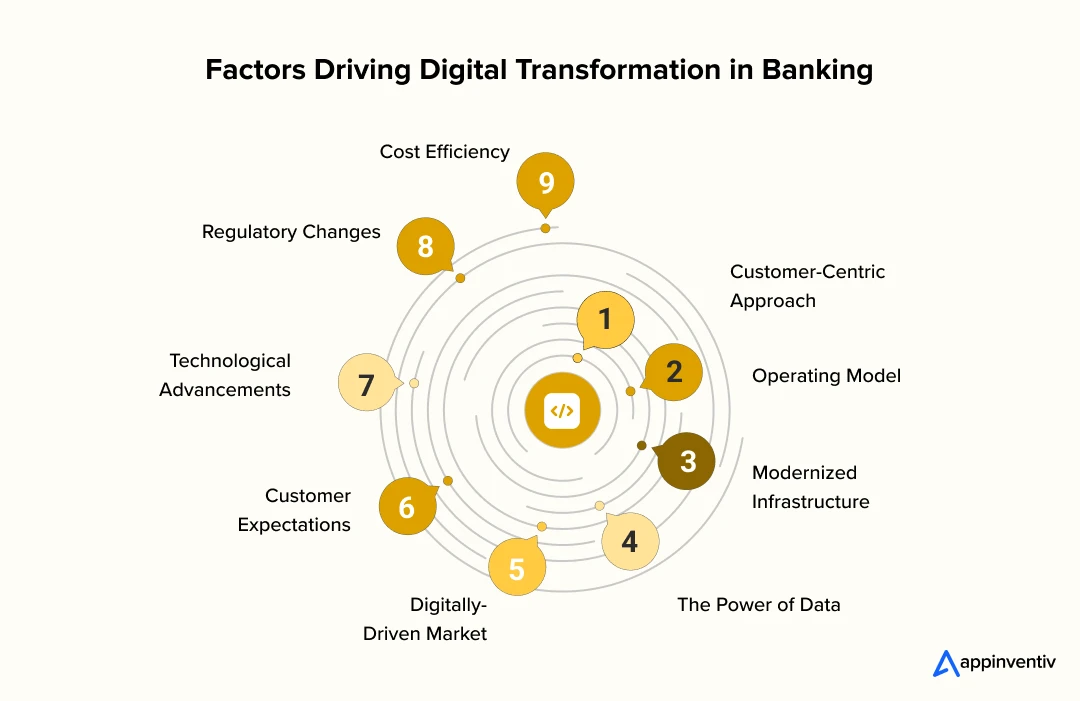
Customer-Centric Approach
Why would banks migrate to digital platforms? Because that’s where their customers are. The digital approach is all about ensuring the needs and expectations of its customers. Banks are now delivering personalized product experience, seamless query disintegration, transparency, and security, standing at the core of customer satisfaction with modern solutions. In short, the digital banking transformation has made it imperative to adopt a “customer approach,” bringing engagement at its best.
Operating Model
Today, customers are in need of a hybrid experience, a combination of speed and convenience with a personalized experience. This is why the digital innovation in the banking sector follows three different operating models.
- Digital as a Business – This is generally at the management level.
- Digital as the New Line of Business – This includes working at the next level as a separate digital division to take care of digital activities.
- Digital Native – This involves a new setup with the business of their own technology stack that focuses directly on consumers.
Modernized Infrastructure
Achieving digital transformation in BFSI is not just about implementing modern technologies. Today, the digital transformation in FinTech has been enhanced due to the underlying infrastructure that facilitates data to the front-end operations. It simply means that modernizing the legacy infrastructure is also a critical factor in driving digital transformation in the banking industry.
The Power of Data
Banking and financial institutions are well aware of the power that consumer data holds. By leveraging advanced data analytics in banking, institutions can analyze and monitor customer behavior, preferences, and trends. This has helped the banking sector produce more relevant products and services aligned with customer needs.
Digitally-Driven Market
We cannot forget how not just banking but every sector, such as industrial, eCommerce, agriculture, IT, etc., is moving ahead with digital capabilities. This includes business culture, technologies, strategies, and skills that contribute to a digital transformation journey. Hence, the entire consumer market is on the verge of transforming digitally, which is one of the driving reasons for digital banking transformation.
Customer Expectations
Customers increasingly wanted the ability to manage their finances on their own terms, which includes 24/7 access, convenience, and real-time transactions. The advent of smartphones and the rise of digital services in other industries (e.g., shopping, entertainment, and social media) created a demand for more agile and accessible banking.
Technological Advancements
With the introduction of cloud computing, mobile apps, artificial intelligence (AI), and blockchain, banks gained access to new tools and platforms that allowed them to enhance customer experiences, streamline operations, and reduce costs.
Regulatory Changes
As financial services changed, governments and regulators started backing digital banking. Rules like the EU’s PSD2 (Payment Services Directive), PCI-DSS, and open banking not only push transparency but also promote innovation, thereby boosting digital banking growth.
Cost Efficiency
Old-school banking depends on physical stuff such as physical branches, ATMs, and huge support crews. Moving to digital platforms lets banks cut operational expenses such as infrastructure rent, staff salary, and utilities while serving more customers with better, personalized services.
So far, we have been talking about digital whereabouts in banking and similar financial institutions. However, we are yet to discover what technologies lead to retail banking digital transformation. Let’s take a broader look at some of the major tools and technologies used by banks to improve operations and customer experience.
Technologies Defining the Today and Tomorrow of Digital Banking for Businesses
When the concept of digital transformation in financial services was initiated, the banks started developing a detailed strategy to revamp their operational models, enhance customer offers, and create an end-to-end customer-centric process. For this process to succeed, the banking sector embraced several tech trends to generate value for both companies and their customers. Below are some of the most used tools and technologies utilized by the digital banking sector.
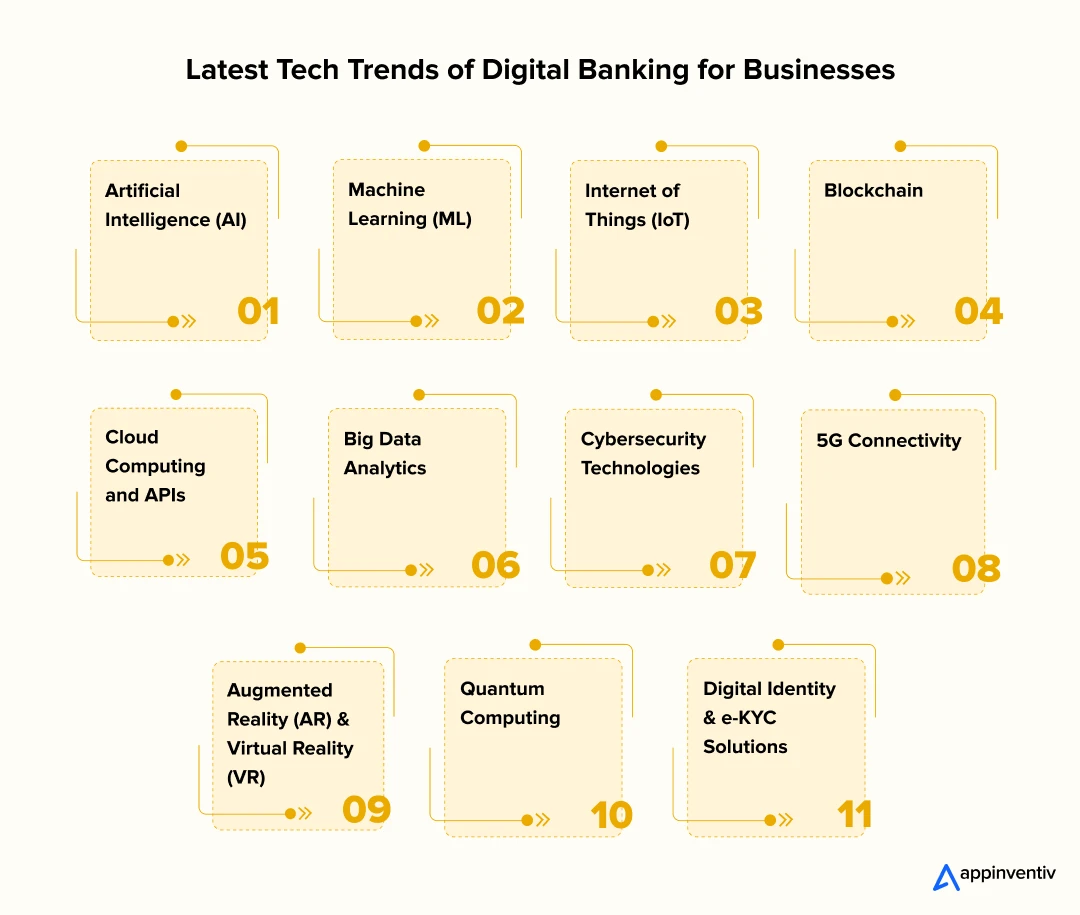
Artificial intelligence (AI)
The power of AI in banking is leveraged by online assistants and chatbots that resolve customer issues instantly. Along with this, artificial intelligence is used for the purpose of data analysis and management, data security, and enhancing customer experience. For instance, AI can detect repetitive patterns by analyzing consumer data within seconds.
Machine learning (ML)
Machine learning is another companion for banks that has the potential to gather, store, and compare user data in real-time. One of the biggest advantages of using Machine learning in the banking sector is fraud detection. This kind of digital transformation for banking makes it easier to detect any change in the user action and take a timely preventive measure.
Internet of Things (IoT)
IoT is super helpful with real-time data analysis, making the customer experience more personal and tailored. Thanks to IoT and its smart connectivity among devices, which empowers customers to seamlessly make contactless payments within seconds. Besides, the Internet of Things has transformed the financial ecosystem by introducing risk management, authorization processes (biometric sensors), and access to multiple platforms.
Blockchain
Every discussion on digital implementation in banking is incomplete without blockchain. The integration of blockchain in banking has resulted in secure data transactions, more accuracy, and an enhanced interface.
Modern customers rigidly trust blockchain solutions and believe that it has made transactions and other banking operations more transparent and convenient. In fact, the fusion of blockchain and IoT (BIoT) has been one of the biggest digital banking technology trends. This technology is also useful in improving cross-border payment systems and minimizing fraud.
Cloud Computing and APIs
Cloud computing is by far the most popular technology utilized by banks and Fintech firms. A cloud-driven service results in improved operations, better productivity, and instant delivery of products and services. With the integration of the cloud, banks are now more open to using FinTech APIs to promote data sharing and enhance the overall experience.
Big Data Analytics
Modern customers don’t look at banks the same way they used to look a decade ago. All thanks to big data technology that helps banks in analyzing customers’ expenditures, monitoring risk, and managing feedback to increase customer loyalty. Data analytics solutions have brought new prospects for financial software development and have been prompt in responding to growing market demands.
Cybersecurity Technologies
With the rapid digitization of services, cybersecurity is no longer optional; it is integral. Modern banks are turning to biometric authentication, multi-factor authentication (MFA), and zero-trust security models to protect sensitive financial data. Advanced threat intelligence platforms and AI agents in fraud detection are also becoming industry standards.
5G Connectivity
The rollout of 5G networks is transforming mobile banking experiences. Faster connectivity allows for smoother mobile transactions, real-time payments, better video-based banking services (like video KYC), and overall reduced latency in digital banking apps.
Augmented Reality (AR) & Virtual Reality (VR)
AR and VR still feel experimental, but these tech trends will certainly redefine the future of digital transformation in banking. Banks are increasingly experimenting with VR-based financial advisory sessions and AR-powered apps that slap spending insights or loan information right onto whatever you’re looking at, making banking way more hands-on and immersive.
Quantum Computing
Quantum computing’s going to revolutionize risk modeling, fraud detection, and real-time data analysis in banking. Heavy hitters like JPMorgan and Goldman Sachs have already started investing in research partnerships with quantum shops to stay ahead of the curve.
Digital Identity & e-KYC Solutions
Digital identity checking and electronic Know Your Customer (e-KYC) have become absolutely crucial. Banks use biometrics, blockchain-based IDs, and bulletproof digital signatures to get customers enrolled quickly while complying with global regulatory requirements.
The above digital transformation trends in banking have not only redefined the banking landscape but also brought some significant benefits to the financial domain. What are these benefits?
[Also Read: Metaverse in banking – How is the technology transforming the future of banks?]
How to Drive Effective Digital Change in the Banking Sector
Digital transformation for banking needs careful planning, smart execution, and nonstop innovation. From grabbing advanced tech to staying compliant and building a change culture, each step matters for long-term success. Let’s check out the key moves here.
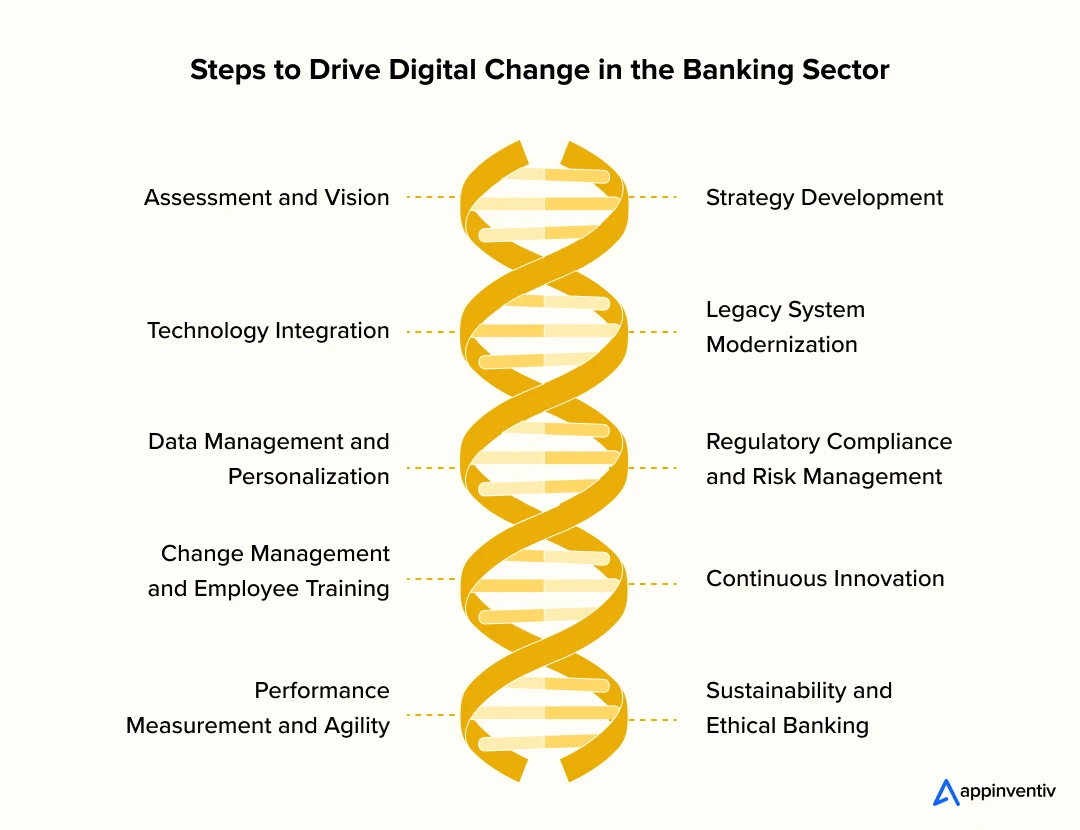
1. Assessment and Vision
Banks need to check where they stand before diving into tech or strategies. This means figuring out operational weak spots, finding customer experience pain points, and studying market shifts. Building a clear vision of what digital transformation in corporate banking looks like and long-term targets are non-negotiable.
This initial step makes sure all subsequent digital moves will match the bank’s overall mission, laying a strong foundation for success.
2. Strategy Development
Crafting a solid strategy comes next. Banks need to map their transformation roadmap by setting clear targets, defining key moves, and deciding which tech and processes to prioritize.
Strategy should use data and consider competition, customer demands, and emerging fintech trends. Key here is making sure digital transformation isn’t a one-time project but an ongoing journey matching bigger organizational goals.
3. Technology Integration
Tech sits at the core of digital transformation in banking. Plugging in modern core banking systems, cloud computing, and AI-driven solutions is crucial for boosting operational efficiency and meeting customer demands.
Also, cybersecurity must be built into every transformation piece to cut risks from data breaches and fraud. Making sure the tech stack scales, stays flexible, and handles future demands is also essential for long-term success.
4. Legacy System Modernization
Old systems create big headaches in digital transformation journeys. Many banks still run outdated, on-premise systems that can’t handle the speed of the digital age. Modernizing these legacy systems becomes vital for smooth integration with new digital tools and platforms.
Cloud migration and grabbing modular setups help banks break free from old system chains and clear paths for smoother, more scalable operations.
5. Data Management and Personalization
Strong data handling forms digital transformation’s backbone. Banks need to integrate big data analytics to better understand customer habits, predict market trends, and personalize offerings. By using customer data, banks create custom experiences that drive loyalty and engagement. Plus, staying compliant with data privacy rules like GDPR and CCPA remains critical for keeping trust and avoiding legal troubles.
6. Regulatory Compliance and Risk Management
Dealing with rules and regulations becomes a huge pain when banks go digital. As they embrace new tech, they need to follow tons of industry rules and keep sensitive data secure.
Risk management strategies, including AI-driven cybersecurity, help protect the bank’s reputation and prevent regulatory issues. This gets super important when banks go digital-first, which usually means sharing customer info with outside companies through open banking connections.
7. Change Management and Employee Training
Digital transformation isn’t really about the tech; it’s about getting people on board. Change management becomes make-or-break for getting employees to actually use new systems instead of fighting them.
This means running training sessions to teach staff how to use digital tools, creating a workplace culture where people want to keep learning new stuff, and giving employees the power to push transformation forward. Good change management makes the whole thing way less painful and actually gets people to stick with new tech in the long-term.
8. Continuous Innovation
Digital landscape changes every five minutes, so banks can’t just set things up and forget about them. Thus, continuous innovation becomes integral. It means constantly tweaking products, services, and processes to stay ahead of competitors.
Listening to when customers complain, messing around with new tech, and watching market trends help banks keep up with what customers actually want. Banks that build innovation into their DNA stay relevant while others get left behind in our tech-obsessed world.
9. Performance Measurement and Agility
Banks need to track whether their digital transformation actually works or just burns money. They should pick and monitor key performance indicators that show customer happiness, how efficiently things run, and whether they’re making more money. Checking these numbers regularly helps banks tweak their approach and make smart decisions based on real data. Using agile methods also helps banks pivot quickly when markets shift or customers want something different.
10. Sustainability and Ethical Banking
Customers increasingly care about whether their bank does good or just makes money. Banking’s future involves not just digital innovation but also doing business responsibly. This might mean funding green energy projects, cutting down on the bank’s own environmental damage, or offering investment options that don’t support terrible companies. Today’s customers prefer to partner with banks that match their green values and follow ethical practices.
Also Read: How Sustainable Banking Is Shaping the Future of FinTech
From strategy development to full implementation, we’re here to guide you every step of the way. Contact us now to start your digital transformation journey.
Challenges of Digital Transformation in Banking And Solutions to Overcome Them
While digital transformation in banking offers vast opportunities, companies still face several challenges along the way. From legacy systems to data security concerns, here’s a look at the most common roadblocks and the strategies to overcome them.
| Challenge | Strategic Solution |
|---|---|
| Outdated Legacy Systems | Transition to modern, cloud-based infrastructure using a phased and modular approach. |
| Data Security & Privacy Risks | Strengthen data security with encryption, zero-trust models, and robust compliance tools. |
| Evolving Regulatory Requirements | Leverage RegTech platforms for real-time compliance monitoring and automated reporting. |
| Low Customer Digital Engagement | Design intuitive platforms and provide digital literacy support to enhance adoption. |
| FinTech Integration Complexity | Utilize APIs and open banking standards to enable smooth collaboration and innovation. |
Benefits of Digital Transformation in Banking and What It Means for Businesses
As we say, the digital banking transformation is more than just instant transactions and online banking. Digitalization in banking brings a lot of new opportunities for small and medium-scale businesses, big corporations, and similar institutions. Digital innovation in banking has led to the following benefits.
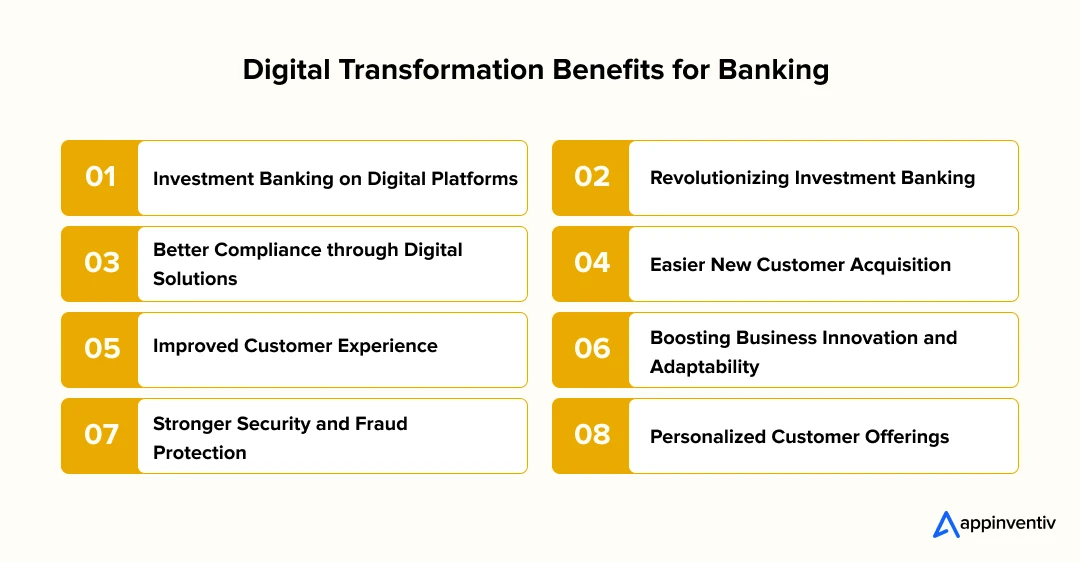
Investment Banking on Digital Platforms
Digital banking expansion streamlined processes by eliminating intermediaries, enhancing data transparency, and providing alternative methods to access intellectual data. These changes slash operational costs and make transactions quicker and more efficient.
Revolutionizing Investment Banking
Digitalization also shifted the landscape by connecting small investors on centralized digital platforms, ditching the need for traditional investment banks. Investment banks now focus on short-term targets, driven by customer demands, which helps digital enterprises and businesses.
Improved Customer Experience
Today’s customers expect the seamless, intuitive experience they get from tech giants. A successful digital transformation delivers just that, with 24/7 access, personalized services, and faster responses.
In 2024, nearly 77% of account holders used digital channels for checking accounts. This signals that delivering a superior digital experience is non-negotiable.
Better Compliance through Digital Solutions
Moving to modern digital financial management systems made it easier for banks to stay compliant. Features like auto-auditing in banking apps cut the time employees spend on manual auditing tasks. Cloud-based digital payroll systems keep banks current with regulations, providing timely updates and cutting manual work.
Easier New Customer Acquisition
Attracting new customers became more cost-effective for financial institutions, and this trend hits all industries. With instant online payments, businesses and customers interact smoothly without hassles, streamlining customer acquisition.
Boosting Business Innovation and Adaptability
Social channels, shopping portals, and mobile banking apps opened fresh avenues for banks and other businesses to connect with customers. This digitization sparked new business innovations that depend heavily on banking services, helping businesses stay adaptable in our increasingly digital world.
Stronger Security and Fraud Protection
Data security has always stayed critical for banks and financial institutions. Advanced software development services now help banks better protect sensitive customer data from threats like fraud, phishing, and hacking, creating safer user experiences.
Personalized Customer Offerings
Digital transformation in banking and financial services has allowed banks to serve exactly what customers need. Instead of guesswork, financial institutions have started formulating their products and offers according to the customer’s daily expenses, and this is by far the biggest benefit of digital banking to its users.
Looking at the above benefits, more enterprises and businesses have adapted to digital transformation solutions and services for better opportunities. What solutions can you leverage for your business?
Top Examples of Digital Transformation Solutions in Modern Banking
Digitalization gives your business full control over end-to-end frontend and backend operations, along with consistency and usability. But how can you get the value of your digitalization efforts? By leveraging digital transformation solutions. Enterprises that adapt advanced digital technologies automatically gain a competitive advantage in the market.
So, what digital solutions can you leverage for your business? Here are some standout examples of digital transformation in banking, showcasing how technological solutions are reshaping modern banking processes.
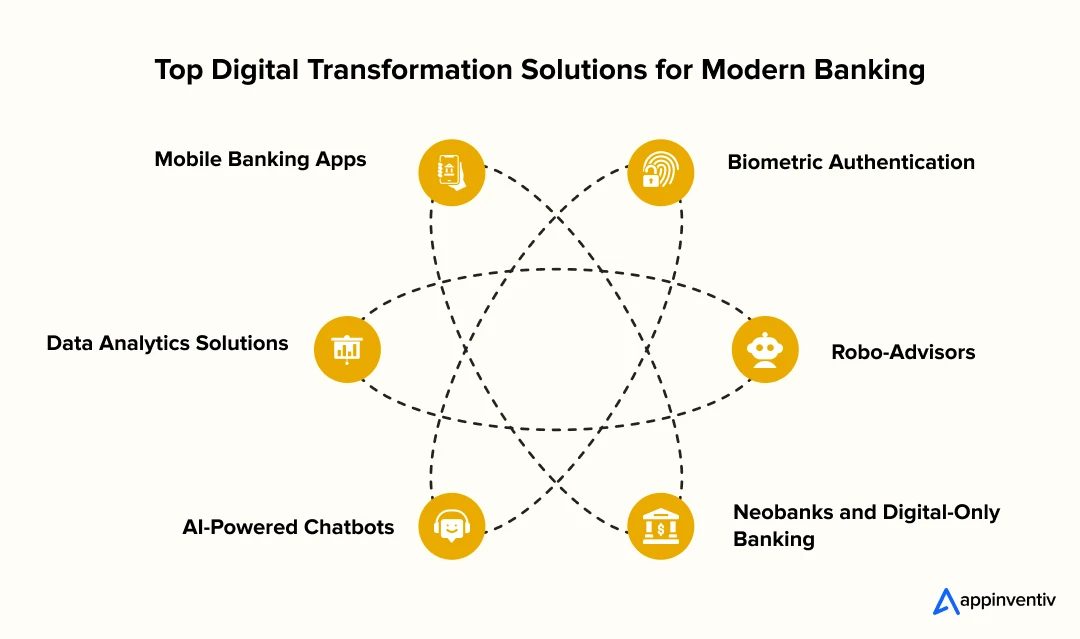
Mobile Banking Apps
Mobile apps are designed to help businesses and consumers in all kinds of ways. Banks now offer mobile apps that enable customers to perform tasks such as transferring funds, checking balances, applying for loans, and making remote deposits, all from the convenience of their smartphones.
Data Analytics Solutions
Deriving the greatest value from the business data is the key to success. If your business deals with massive amounts of data from multiple sources, data analytics solutions for banking can help you transform your everyday data into valuable business insights.
AI-Powered Chatbots
Many banks have integrated AI-driven chatbots to provide instant customer support, answer queries, and complete transactions. This reduces the need for human agents and improves efficiency, offering around-the-clock service to clients.
Neobanks and Digital-Only Banking
Popular neobanks like Chime, Monzo, and Revolut are entirely digital, offering financial services without the overhead of physical branches. They provide easy-to-use platforms with lower fees and a streamlined customer experience.
Also Read: Understanding the Neobank App Development Cost
Robo-Advisors
Robo-advisors platforms, powered by AI and ML algorithms, help customers manage their investments by offering automated, personalized advice at a lower cost than traditional wealth management services.
Biometric Authentication
By integrating biometric authentication (e.g., fingerprint scanning, facial recognition, and voice ID), banks are making account access more secure while providing a seamless user experience.

Real-World Examples of Banks That Have Reaped the Rewards of Digital Transformation
Digital transformation isn’t just buzzwords; it’s already flipping some of the world’s biggest banks upside down. From Asia to Europe and the US, several financial institutions have embraced the technological trends and saw real results, from fatter profits to happier customers. Here are some standout examples of leading banks.
DBS Bank (Singapore)
DBS, one of the world’s most advanced digital banks, is a great example of digital banking transformation. It split itself into 30+ digital platforms, dumped serious cash into cloud and AI, and slashed the time needed to deploy new AI models from 18 months down to just five.
Today, DBS runs over 600 AI and machine learning models across hundreds of use cases, powering everything from fraud catching to customer personalization. The payoff is obvious: digital customers make more money, cost less to handle, and helped DBS consistently gain recognition as the “World’s Best Digital Bank.”
BBVA (Spain)
Spain’s BBVA became a textbook case of how retail banking digital transformation delivers measurable returns. By moving core services to the cloud, adopting advanced analytics, and using APIs to hook up with fintech partners, BBVA shifted most of its customer interactions online.
The result? Nearly 50 million people now use its digital channels, and over 70% of its sales happen digitally. The bank also saw sharp efficiency improvements, with its cost-to-income ratio becoming one of Europe’s strongest.
In Peru, BBVA’s digital-first onboarding process helped new customers adopt over twice as many products as before, showing how digitization boosts both customer engagement and revenue.
JPMorgan Chase (United States)
JPMorgan Chase, America’s largest bank, leaned hard into cloud computing to future-proof operations. By moving nearly 70% of its data and about half its applications to the cloud, the bank managed to increase scalability without raising infrastructure costs significantly.
This move freed up tons of cash and resources they could throw at AI, advanced analytics, and things that actually help customers. All this modernization has made JPMorgan significantly more flexible and ready to adapt to whatever customers want next, instead of getting stuck with outdated systems like their competitors.
The Future of Digital Transformation in Banking
The journey of banking and digital transformation is far from over. The next chapters will get shaped by several key trends:
- Banking as a Service (BaaS): Banks will increasingly offer their core services (payments, lending, etc.) through APIs to third-party companies, letting non-financial brands stick banking services right into their own apps.
- Open Banking: This trend gives customers secure ways to share their financial information with other approved organizations. This will create financial dashboards where you can see all your accounts from different banks in one spot.
- Hyper-Personalization at Scale: Using AI, banking will become truly predictive. Your bank will know you need a car loan before you even start looking, offering you a pre-approved rate at exactly the right moment.
Starting this journey requires the right partners. Working with an expert banking software development services provider can provide the technical know-how and strategic guidance to handle the complexities of this evolution.
Sail Through Your Digital Transformation Journey in Banking with Appinventiv
At the core, digital transformation in banking is not a checkbox. It’s a journey, full of pivots, lessons, and reinvention. And you need a trusted tech partner to accompany you in this digital journey. This is where we come in.
At Appinventiv, we don’t just enable change; we steer it. Our banking software development services have helped many FinTech firms like Mudra and EdFundo to create real, measurable impact. For instance:
We built Mudra, an AI-powered, chatbot-centric budget management platform to assist millennials in managing their finances.
The Result?
- 12+ nations adopted the app
- An AI-driven banking solution
Our team developed Edfundo, a financial literacy and money-management app to teach kids sound money habits through interactive modules and parental oversight.
The Result?
- $500K pre-seed funding received
- #1 FinTech startup award
These are not just FinTech success stories; they are proof that digital transformation, when done right, works wonders for businesses.
If your bank or financial business is ready to move beyond superficial digitization toward transformation that sticks, that evolves, that delivers, then partnering with us means you get more than code. You get strategy, architecture, execution, and a track record of turning ideas into growth engines.
Talk to us for customized digital transformation services for your banking business.
FAQs
Q. What is digital transformation in banking?
A. Digital transformation in banking involves embedding digital technology across every facet of a bank’s operations. This shift fundamentally alters how banks function and provide value, leading to greater efficiency, improved customer experiences, and increased innovation.
In short, digital transformation in banking is a complete overhaul, which involves;
- Shifting from a product-centric to a customer-obsessed mindset.
- Leveraging data to create deeply personalized experiences.
- Automating core processes for speed, efficiency, and accuracy.
- Adopting agile technologies like cloud computing, AI, and blockchain to build a flexible foundation.
Q. What are some key benefits of digital transformation in banking?
A. Some of the key benefits of digital transformation banking include:
- Improved Data Management
- Cost Savings
- Strengthened Security and Compliance
- Operational Efficiency
- Enhanced Customer Experience
Q. How do banks measure ROI from digital transformation?
A. Banks measure ROI from digital transformation through several key metrics. These include cost savings from automation and cloud adoption, increased revenue from digital channels, and faster transaction processing, which enhances operational efficiency.
Additionally, customer acquisition and retention rates provide clear indicators of success, with improvements in customer satisfaction and engagement often leading to higher profits over time.
Q. What are common mistakes banks make during digital transformation?
A. Here are some common mistakes banks often make during their digital banking transformation journey:
- Focusing solely on technology without aligning it with business strategy.
- Failing to modernize legacy systems, which causes integration issues.
- Neglecting the importance of cybersecurity, exposing the bank to fraud.
- Not investing enough in employee training, leading to poor adoption of new tools.
Q. What is the difference between digitization and digital transformation in banking?
A. Here is the basic difference between digitization and digital transformation in banking:
Digitization: Converting physical processes into digital form (e.g., scanning paper documents).
Digital transformation: Redesigning operations, customer experiences, and business models using modern technologies.
Q. How should traditional banks approach digital transformation compared to fintechs?
A. Traditional banks often face more complex challenges when adopting digital transformation due to their legacy systems, strict regulations, and the need for gradual change.They should take a phased approach, upgrading core infrastructure while ensuring compliance and mitigating risks. Fintechs, however, have the advantage of starting from scratch with digital-first models, enabling them to innovate quickly and scale without the constraints of legacy systems. Their approach is more agile, focusing on rapid experimentation and customer-centric innovation.
Q. What role does blockchain play in banking transformation?
A. With blockchain technology, banks are making transactions faster, more transparent, and more secure. Moreover, blockchain facilitates faster and more efficient cross-border payments, reducing the time and cost typically involved. Additionally, smart contracts powered by blockchain can automate various banking processes, enhancing efficiency and security in transactions.


- In just 2 mins you will get a response
- Your idea is 100% protected by our Non Disclosure Agreement.

How Gamification in Banking Helps Enterprises Build Lasting Customer Loyalty
Key takeaways: A winning banking gamification strategy isn't about badges; it’s about using behavioral psychology to form daily financial habits. Industry leaders like DBS Bank and Revolut prove the concept works, driving higher savings and millions in user acquisition. The cost to implement gamification in banking and financial services ranges between $40,000 and $400,000 or…

KYC Automation - Benefits, Use Cases, Steps, Tools and Best Practices
Key takeaways: KYC automation cuts verification from days to minutes and keeps checks consistent across teams. AI and ML reduce manual errors, catch risk earlier, and make compliance far easier to scale. Manual KYC drains time, increases cost, and slows onboarding — automation fixes all three. Automated workflows handle spikes in customer volume without compromising…
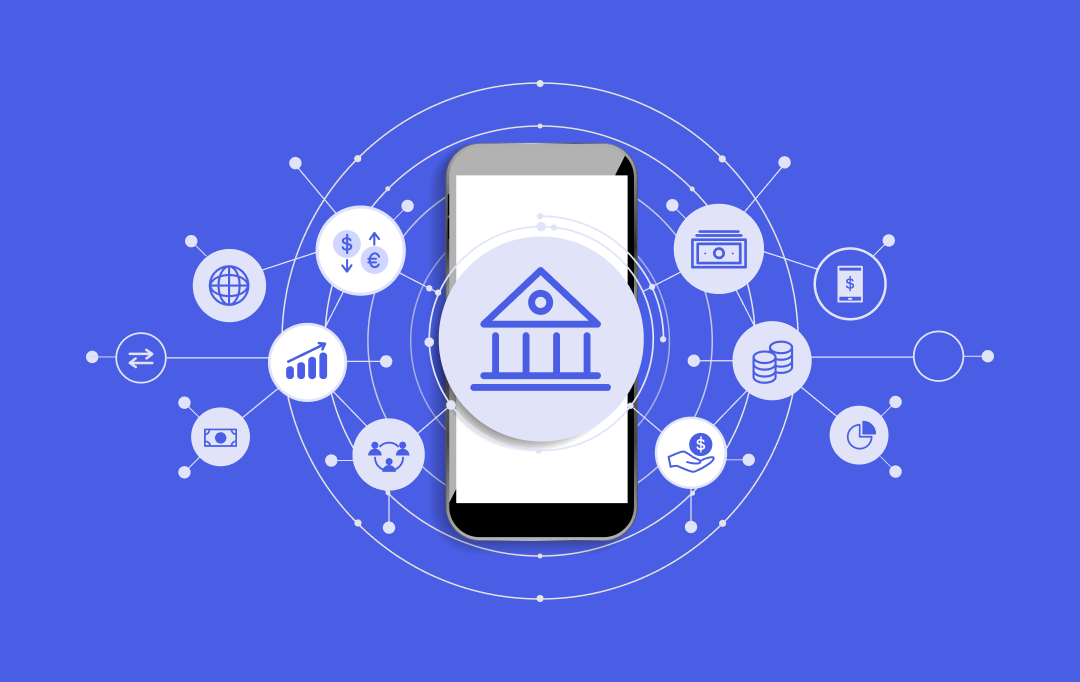
How to Modernize Legacy Systems in Banking: Key Strategies and Steps
Key takeaways: Legacy systems burn cash and slow things down, so modernization is essential to stay compliant and competitive. Methods like replatforming, refactoring, or a hybrid approach let banks upgrade piece by piece without breaking everything. Tech trends like cloud computing, AI, and blockchain make modernization happen faster, fixing efficiency, customer service, and safety. Banks…























